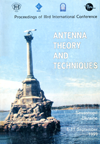Modeling of non-coordinate electromagnetic problems
DOI:
https://doi.org/10.1109/ICATT.1999.1236150Abstract
Estimation of excited or diffracted field by an element arranged in surrounded structure forms an electro-magnetic problem. In the case, when the field tensions of an element could be written in the different coordinate system than the structure field tensions, the electromagnetic problem is considered as a non-coordinate problem. Direct transformation of one coordinate system into another often makes the analysis more difficult. Physical modeling of the element allows to write this field tensions in the structure-coordinate system.References
Collin, Robert E. Field Theory of Guided Waves. London: McGraw-Hill, 1960, 591 p.
Glisson, Allen W.; Wilton, Donald R. Simple and efficient numerical methods for problems of electromagnetic radiation and scattering from surfaces. IEEE Trans. AP, Sept. 1980, Vol. 28, No. 5.
Jarem, John M. A multifilament method-of-moments solution for the input impedance of a probe-excited semi-infinite waveguide. IEEE Trans. MTT, Jan. 1987, Vol. 35, No. 1, p. 14-19.
Leviatan, Yehuda; Li, Ping G.; Adams, Arlon T.; Perini, Jose. Single post inductive obstacle in rectangular waveguide. IEEE Trans. MTT, Oct. 1983, Vol. 31, No. 10, P. 806-812.
Leviatan, Yehuda; Schaffer, Gad S. Analysis of inductive dielectric posts in rectangular waveguide. IEEE Trans. MTT, Jan. 1987, Vol. 35, No. 1, P. 48-59.
Rao, Sadisava M.; Wilton, Donald R.; Glisson, Allen W. Electromagnetic scattering by surfaces of arbitrary shape. IEEE Trans. AP, May 1982, Vol. 30, No. 3.
Model', A. M.; Savitskiy, A.Yu. Diffraction of H10 wave of a rectangular waveduide on an array of circular inductive rods. Radiotekhnika, 1986, No. 4, p. 13-18.

